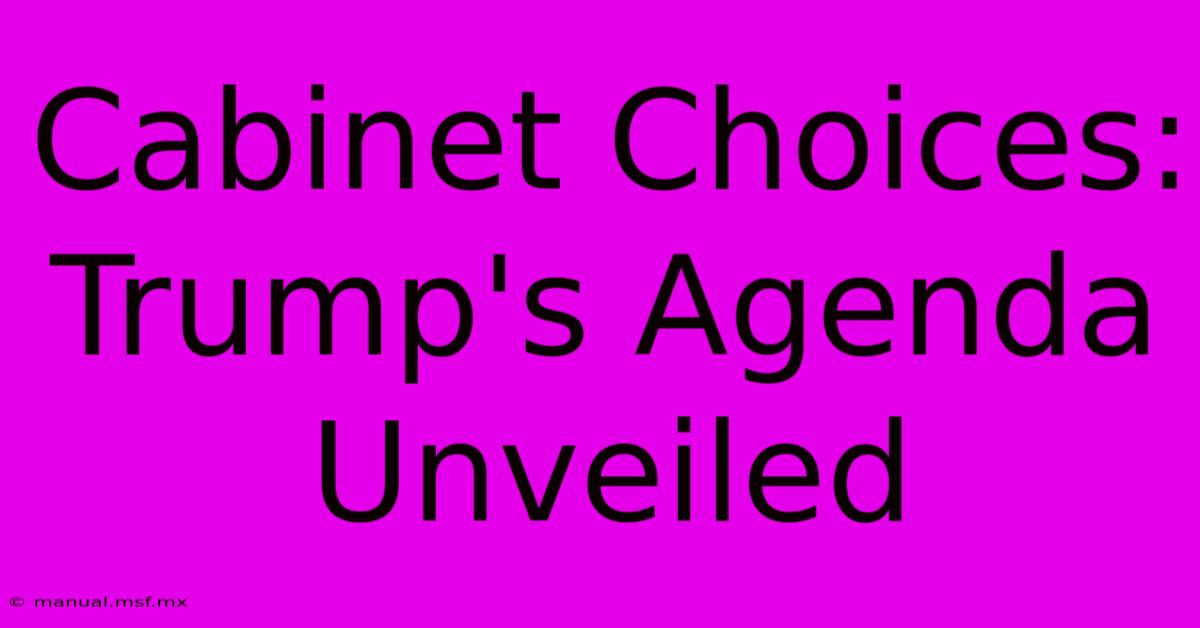Cabinet Choices: Trump's Agenda Unveiled

Discover more detailed and exciting information on our website. Click the link below to start your adventure: Visit Best Website. Don't miss out!
Table of Contents
Cabinet Choices: Trump's Agenda Unveiled
Is the composition of a president's cabinet a true indicator of their policy intentions? The selection of cabinet members reveals a president's priorities and offers crucial insights into their governing agenda. This analysis delves into the significance of cabinet appointments and examines how President Trump's cabinet choices reflected his policy objectives.
Editor Note: President Trump's cabinet appointments during his administration were highly scrutinized and have become a subject of ongoing debate. This analysis aims to shed light on the potential connections between cabinet choices and policy outcomes.
Why is this important? The cabinet is a key advisory body to the president, influencing policy decisions and shaping the direction of the nation. Understanding the choices made by a president can help us predict potential policy changes and assess the long-term impact of their administration.
Analysis: This analysis examines the composition of President Trump's cabinet, exploring the backgrounds, qualifications, and potential agendas of key appointees. We consider the alignment of these individuals with President Trump's campaign promises and investigate the potential implications of their appointments on various policy areas. We will delve into the specific policy areas influenced by the cabinet choices, including but not limited to:
- Economic Policy: The potential effects of appointing individuals with specific financial backgrounds on economic policy decisions.
- Foreign Policy: The impact of the appointment of individuals with experience in national security and international relations on foreign policy objectives.
- Environmental Policy: The influence of cabinet members' views on climate change and environmental regulations on environmental policy.
- Healthcare Policy: The potential ramifications of appointees' positions on healthcare reform and access to healthcare.
Key Takeaways of President Trump's Cabinet Appointments
| Policy Area | Key Aspects | Potential Impact |
|---|---|---|
| Economic Policy | Appointment of individuals with financial backgrounds, emphasis on deregulation | Potential for tax cuts, deregulation, and pro-business policies. |
| Foreign Policy | Appointment of individuals with military and national security experience, focus on a strong military presence | Potential for a more assertive foreign policy and a shift towards isolationism. |
| Environmental Policy | Appointment of individuals skeptical of climate change, focus on deregulation of environmental regulations | Potential for a rollback of environmental protections and reduced regulations. |
| Healthcare Policy | Appointment of individuals opposed to the Affordable Care Act, emphasis on market-based solutions | Potential for a repeal or significant changes to the Affordable Care Act. |
Cabinet Choices: A Deeper Dive
The Role of the Cabinet
The cabinet is a vital part of the presidential administration, playing a crucial role in policy formation and execution. Cabinet members are appointed by the president and confirmed by the Senate. They lead executive departments, providing expertise and advice on specific policy areas. Their decisions significantly impact the implementation of the president's agenda.
Economic Policy: President Trump's cabinet appointments reflected his emphasis on economic growth and job creation. He appointed individuals with strong financial backgrounds and a commitment to deregulation. This approach signaled a potential shift toward pro-business policies, including tax cuts and relaxed regulations.
Foreign Policy: President Trump's cabinet selections indicated a focus on national security and a more assertive foreign policy. His choices included individuals with military experience and a history of advocating for a strong military presence globally. These appointments hinted at a possible shift toward a more isolationist approach to international relations.
Environmental Policy: President Trump's cabinet appointments raised concerns about the future of environmental policy. His selections included individuals skeptical of climate change and committed to rolling back environmental regulations. This led to worries about a weakening of environmental protections and a disregard for climate change mitigation.
Healthcare Policy: President Trump's cabinet choices suggested a strong desire to dismantle or significantly modify the Affordable Care Act. His appointments included individuals who had previously campaigned against the law and advocated for market-based healthcare solutions. This signaled a potential for a major overhaul of the US healthcare system.
Conclusion:
The composition of a president's cabinet provides valuable insights into their policy intentions. By examining the backgrounds, qualifications, and potential agendas of cabinet members, we can gain a better understanding of the direction of the administration. President Trump's cabinet selections revealed his focus on economic growth, national security, deregulation, and a possible shift towards a more isolationist foreign policy. While the long-term impact of his cabinet choices remains to be seen, it is clear that they have played a significant role in shaping his administration's policies.

Thank you for visiting our website wich cover about Cabinet Choices: Trump's Agenda Unveiled. We hope the information provided has been useful to you. Feel free to contact us if you have any questions or need further assistance. See you next time and dont miss to bookmark.
Also read the following articles
| Article Title | Date |
|---|---|
| Evercores Eaton Rating Review | Nov 14, 2024 |
| Burgess Selected For Australia Squad | Nov 14, 2024 |
| Bali Vulkanausbruch Bringt Urlauber In Not | Nov 14, 2024 |
| Maldinis Omschakeling Naar Tennis | Nov 14, 2024 |
| Gaetz Nominated To Justice Department By Trump | Nov 14, 2024 |
| Nba Live Grizzlies Vs Lakers Where To Watch | Nov 14, 2024 |
| Find Taylor Swift Toronto Nov 14 Tickets | Nov 14, 2024 |
| Debate Erupts John Krasinski Sexiest Man | Nov 14, 2024 |
| World Cup Qualifiers 2024 Late Draw For Socceroos | Nov 14, 2024 |
| Forlan Keert Terug Naar Voetbal In Uruguay | Nov 14, 2024 |
